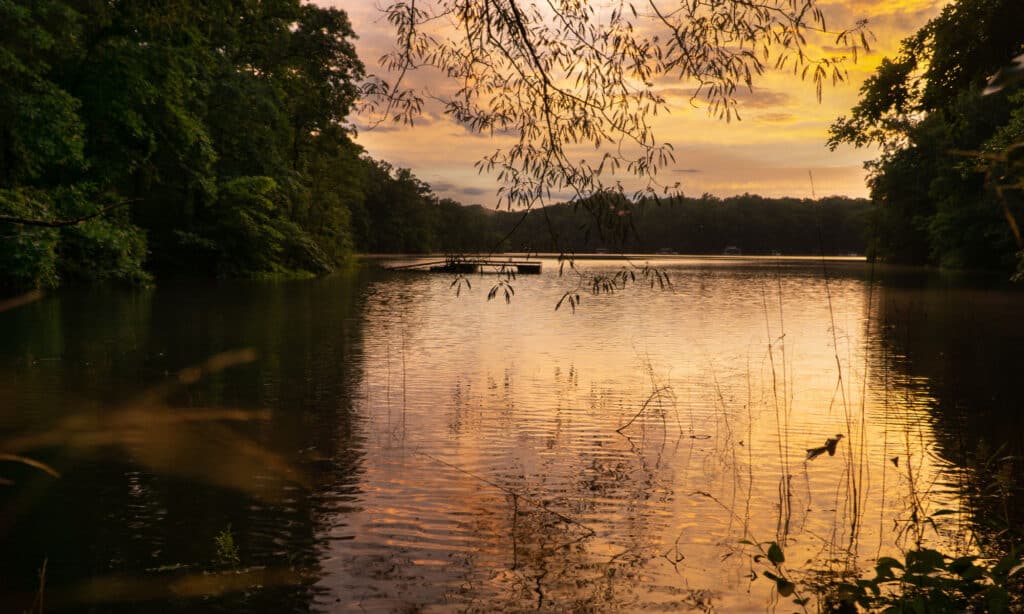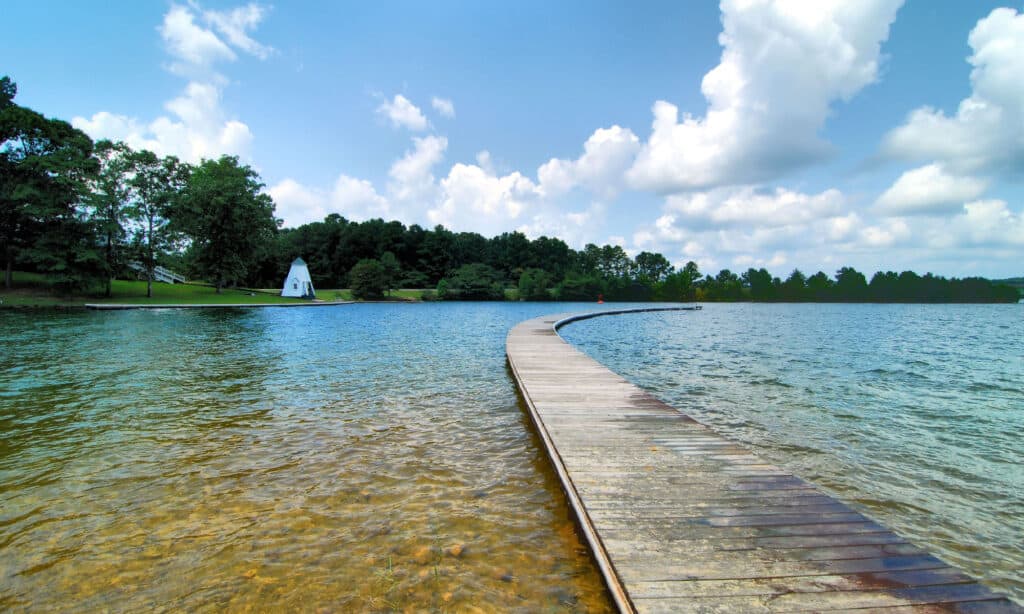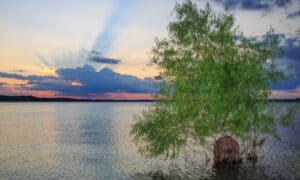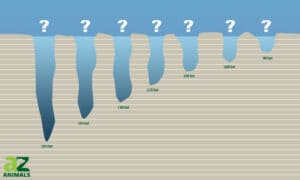The 10 Most Snake Infested Lakes in the United States
@media (min-width: 481px) {
.mobile-top-content {
display: none;
}
}
#mobileTopContentCTACarouselControls { overflow: hidden; text-overflow: ellipsis; white-space: nowrap; }
.mobile-top-content .more { color: #fff; }
.mobile-top-content a { color: #fff; text-decoration: underline; }
.mobile-top-content a:hover { color: #fff; text-decoration: underline; }
@media (max-width: 480px) {
.mobile-top-content {
background-color: #06a10b;
color: #fff;
text-align: center;
/*height: 60px;
padding-top:5px;*/
font-size:80%;
/* display: block; */
margin: 0px -30px;
}
}
Key Points:
- Fifteen species of aquatic snakes inhabit the water sources of the United States.
- The only venomous, aquatic snake in the U.S. is the cottonmouth (water moccasin) snake.
- Out of all of the lakes in the country, the most snake-infested lake is Lake Sweetwater, Texas.
Snakes are found all over the United States, however, not every state has snakes. From forest to desert, and even water sources, these snakes inhabit a wide array of environments across the country. Next time you are swimming in your favorite lake, keep an eye out for snakes, as there are 15 aquatic species in the country. You will, however, be relieved to hear that the United States only has one deadly water-dwelling snake, so it’s not likely a concern.
Of the four venomous snakes found in the United States, the cottonmouth, sometimes known as the water moccasin, is the only dangerous snake found in the country that lives predominantly in or near water. Water snakes can be found near any significant water source, including rivers, lakes, ponds, and marshes, though they prefer quieter environments. With that in mind, we need to know where these snakes thrive so we can be on the lookout for them. Below, we will explore the 10 most snake-infested lakes in the United States.
The 10 Most Snake Infested Lakes in the United States
10. Lake Hartwell, Georgia

iStock.com/Ashley Strickland Photography
When visiting the Lake Hartwell area, you will undoubtedly encounter a variety of species, but one, in particular, you may want to avoid: the Georgia copperhead snake. They live in a wide variety of habitats, from forests to rocky areas and lakes. The color of these snakes ranges from light to dark, tan, and brown. The bright copper color of their heads is their “signature characteristic,” but it’s crucial to remember that not all of them have it. People new to the area or inexperienced with snakes on Lake Hartwell may confuse the copperhead with the northern water snake, which has similar colors and markings. A copperhead snake shakes its tail before biting, similar to a rattlesnake, although it doesn’t have rattles. It will instead exude a strong musk. So, if you smell something, get out of there.
9. Collinsville Lake, Oklahoma
If you enjoy the lakes in Oklahoma, keep in mind that there is a hidden danger. Cottonmouth snakes, which are highly venomous, are widespread around all of their bodies of water. Unfortunately, Collinsville Lake is one of them. Cottonmouths are semiaquatic, meaning they can swim in the water (hence their other popular name, water moccasin) and bask on land. They are the only venomous snakes that spend a lot of time in the water in the United States. Cottonmouths, like copperheads and rattlesnakes, are pit vipers. They feature heat-sensing facial pits between their eyes and nose. These unique pits can detect minute temperature variations, allowing the snake to precisely hit the source of heat, which is frequently potential prey.
8. Lake Martin, Alabama

iStock.com/Shackleford-Photography
Snakes are one of Alabama’s most divisive species and are one of the most likely to elicit a reaction when spotted. Fortunately, only six of these numerous species are venomous. Timber rattlesnakes, pygmy rattlesnakes, copperheads, and cottonmouths are four of the six venomous species found in the Lake Martin area and throughout the state. These snakes are frequently regarded as “bad guys” due to their deadly nature, and they receive a lot of negative attention and press. Copperheads are perhaps the least feared of the four. Maybe it’s because copperheads lack the water moccasin’s unsightly body and aggressive behavior or the rattlesnake’s auditory warning and intimidating reputation. Copperheads are beautiful, non-aggressive pit vipers with the least lethal venom of any native dangerous snake in the United States.
7. Lake Gaston, Virginia

EnterTheLight/Shutterstock.com
The copperhead, cottonmouth, and timber rattlesnake are three venomous snake species still found in or near Lake Gaston today. The cottonmouth and copperhead are the most active snakes in this area, and the latter is the most likely to bite you. The bite of any pit viper usually results in pain, swelling, bruising, and redness at the bite site. It’s due to blood toxins interfering with the body’s capacity to coagulate blood.
6. Lake Texoma, Texas

iStock.com/asiantiger247
Texoma is home to many different species of snakes. As the weather warms up, so do the snakes. There are four types of venomous snakes in Texoma Lake: Copperhead, cottonmouth, rattlesnake, and coral snake. If people study those four types, they’ll be able to rule out all other snakes they come across as venomous. Most of them aren’t, and the coral snake is native to Texas. Coral snakes are venomous snakes that are small and brightly colored. They have the second-strongest venom of any snake (the black mamba is the first), yet they are regarded as less hazardous than rattlesnakes because their poison delivery method is less effective. Identify the snake before going near it, stay calm, and, if needed, call for help to have a venomous snake relocated.
5. Lake Okeechobee, Florida

Allison Michael/Shutterstock.com
The South Florida region is home to 34 of Florida’s 46 native snake species, including four of the six venomous species. In addition, South Florida is also home to three non-native species, while timber rattlesnakes and copperheads are exclusive to North Florida. Burmese pythons may reign supreme over all other creepy-crawlies in a state teeming with them. In recent decades, they have grown from a small population in the southern Everglades to the Naples area and even as far north as Lake Okeechobee. Everything is potential prey: from relatively small wading birds and rabbits to large deer and even alligators. The pattern on their camouflage is nearly perfect. Even adults may have difficulty spotting them when lurking in the grasses and under shrubs.
4. Lake Tahoe, California

iStock.com/heyengel
As the weather warms up and more people go for picnics and swim outdoors, they must be alert to their surroundings. Rattlesnakes thrive in the Lake Tahoe Basin, and spring is when they emerge from their winter hibernation. Although rattlesnakes are venomous, they usually keep to themselves. While sightings of snakes sunbathing in the middle of the day are common, they spend a surprising amount of time out and about at night, especially during the summer. Three species of garter snakes comprise the aquatic reptile fauna of the Lake Tahoe basin: the common garter snake, the western terrestrial garter snake, and the Sierra garter snake. Even with the high elevation environment of the Lake Tahoe basin, small mountain streams appear to offer limited habitat for most aquatic-associated vertebrates, particularly amphibians and snakes.
3. Lake Mead, Arizona

iStock.com/Sean Pavone
Forty-one species of reptiles and 12 species of amphibians thrive at Lake Mead. Snakes are abundant across the region, as one might anticipate in a warm environment. There are four species of rattlesnakes found within the recreation area, and all are considered deadly. Their venom is highly toxic, and they administer it quickly. All have hollow, hypodermic-like fangs in the front of their upper jaws connected to larger venom glands by a channel. They all make the distinctive rattle that gives them their name. Another species is the King snake, one of the best-known and readily identified non-venomous snakes. It has a striking black or extremely dark brown pattern with white to cream-colored rings along its length. When temperatures allow, it’s diurnal, but when temperatures rise too high, it becomes crepuscular or nocturnal.
2. Lake Erie, Michigan

iStock.com/becky johnson
The population of Lake Erie water snakes is approaching 12,000. It was the 23rd species to be removed from the federal Endangered Species List in 2011, joining the bald eagle, American alligator, and peregrine falcon. About 300 acres of the inland habitat and 11 miles of shoreline also were protected from the water snake. The Lake Erie Watersnake is a massive, non-venomous snake native to Lake Erie’s islands. This snake is highly aquatic, as its name implies, and lives far from the shoreline. The body is pale grey to dark brown, with a subtle pattern of darker grey or brown bands. They spend most of the day foraging amphibians and fish in or near water. The rocky beaches of the Lake Erie islands it calls home provide plenty of opportunities for sunbathing and concealment.
1. Lake Sweetwater, Texas

Michael R Ross/Shutterstock.com
If you’re curious about which state has the most snakes, look no further. The number of species in Texas is the highest. In terms of areas of Texas with a large population, West Texas, Central Texas, and South Texas are excellent places to look for snakes. The World’s Largest Rattlesnake Roundup attracts an estimated 25,000 visitors to Sweetwater each March, infusing $8.3 million into the local economy. Sweetwater’s history and culture intertwine with the roundup. It all started in 1958 when local farmers and ranchers tried to eradicate the local western diamondback rattlesnake population that attacked cattle and pets. Hunters capture the snakes who compete for the largest ones and take them to the Nolan County Coliseum. However, not everyone is a fan. Ecologists and animal rights activists have criticized the event, but it hasn’t deterred what has become a cultural and economic pillar in Sweetwater, uniting generations of its citizens.
Other Aquatic Snakes in the US
Aquatic species of snakes in the United States are found in both saltwater and freshwater and various habitats. If you’re curious as to what the other aquatic snake species are in the U.S., here are a few:
- Common Watersnake – Eastern U.S.
- Plain-bellied Watersnake – Southeast U.S.
- Queen Snake – Scattered eastern U.S.
- Saltmarsh Watersnake – Coast of Gulf of Mexico
Summary
| Highest to Lowest Snake Population | Lake | State |
|---|---|---|
| #1 | Lake Sweetwater | TX |
| #2 | Lake Erie | MI |
| #3 | Lake Mead | AZ |
| #4 | Lake Tahoe | Ca |
| #5 | Lake Okeechobee | FL |
| #6 | Lake Texoma | TX |
| #7 | Lake Gaston | VA |
| #8 | Lake Martin | AL |
| #9 | Collinsville Lake | OK |
| #10 | Lake Hartwell | GA |
Up Next…
Now we’ve learned the importance of researching a lake before swimming in it. If you’re curious about where else snakes inhabit the U.S. and how big they might be, check out our articles:
- The 10 Most Snake Infested Areas in the US – Where in the U.S. you’re most likely to find snakes!
- Snake Population By State – Are you living in a snake-infested area?
- Largest Snake in the US Discovered (Up to 500+ Pounds!) – Where and how big is the largest snake in the United States? Find out!
More from A-Z Animals
.more-snake-card-image { max-height:140px !important; }
@media (min-width: 481px) {
.mobile-top-content {
display: none;
}
}
#mobileTopContentCTACarouselControls { overflow: hidden; text-overflow: ellipsis; white-space: nowrap; }
.mobile-top-content .more { color: #fff; }
.mobile-top-content a { color: #fff; text-decoration: underline; }
.mobile-top-content a:hover { color: #fff; text-decoration: underline; }
@media (max-width: 480px) {
.mobile-top-content {
background-color: #06a10b;
color: #fff;
text-align: center;
/*height: 60px;
padding-top:5px;*/
font-size:80%;
/* display: block; */
margin: 0px -30px;
}
}
Key Points:
- Fifteen species of aquatic snakes inhabit the water sources of the United States.
- The only venomous, aquatic snake in the U.S. is the cottonmouth (water moccasin) snake.
- Out of all of the lakes in the country, the most snake-infested lake is Lake Sweetwater, Texas.
Snakes are found all over the United States, however, not every state has snakes. From forest to desert, and even water sources, these snakes inhabit a wide array of environments across the country. Next time you are swimming in your favorite lake, keep an eye out for snakes, as there are 15 aquatic species in the country. You will, however, be relieved to hear that the United States only has one deadly water-dwelling snake, so it’s not likely a concern.
Of the four venomous snakes found in the United States, the cottonmouth, sometimes known as the water moccasin, is the only dangerous snake found in the country that lives predominantly in or near water. Water snakes can be found near any significant water source, including rivers, lakes, ponds, and marshes, though they prefer quieter environments. With that in mind, we need to know where these snakes thrive so we can be on the lookout for them. Below, we will explore the 10 most snake-infested lakes in the United States.
The 10 Most Snake Infested Lakes in the United States
10. Lake Hartwell, Georgia

iStock.com/Ashley Strickland Photography
When visiting the Lake Hartwell area, you will undoubtedly encounter a variety of species, but one, in particular, you may want to avoid: the Georgia copperhead snake. They live in a wide variety of habitats, from forests to rocky areas and lakes. The color of these snakes ranges from light to dark, tan, and brown. The bright copper color of their heads is their “signature characteristic,” but it’s crucial to remember that not all of them have it. People new to the area or inexperienced with snakes on Lake Hartwell may confuse the copperhead with the northern water snake, which has similar colors and markings. A copperhead snake shakes its tail before biting, similar to a rattlesnake, although it doesn’t have rattles. It will instead exude a strong musk. So, if you smell something, get out of there.
9. Collinsville Lake, Oklahoma
If you enjoy the lakes in Oklahoma, keep in mind that there is a hidden danger. Cottonmouth snakes, which are highly venomous, are widespread around all of their bodies of water. Unfortunately, Collinsville Lake is one of them. Cottonmouths are semiaquatic, meaning they can swim in the water (hence their other popular name, water moccasin) and bask on land. They are the only venomous snakes that spend a lot of time in the water in the United States. Cottonmouths, like copperheads and rattlesnakes, are pit vipers. They feature heat-sensing facial pits between their eyes and nose. These unique pits can detect minute temperature variations, allowing the snake to precisely hit the source of heat, which is frequently potential prey.
8. Lake Martin, Alabama

iStock.com/Shackleford-Photography
Snakes are one of Alabama’s most divisive species and are one of the most likely to elicit a reaction when spotted. Fortunately, only six of these numerous species are venomous. Timber rattlesnakes, pygmy rattlesnakes, copperheads, and cottonmouths are four of the six venomous species found in the Lake Martin area and throughout the state. These snakes are frequently regarded as “bad guys” due to their deadly nature, and they receive a lot of negative attention and press. Copperheads are perhaps the least feared of the four. Maybe it’s because copperheads lack the water moccasin’s unsightly body and aggressive behavior or the rattlesnake’s auditory warning and intimidating reputation. Copperheads are beautiful, non-aggressive pit vipers with the least lethal venom of any native dangerous snake in the United States.
7. Lake Gaston, Virginia

EnterTheLight/Shutterstock.com
The copperhead, cottonmouth, and timber rattlesnake are three venomous snake species still found in or near Lake Gaston today. The cottonmouth and copperhead are the most active snakes in this area, and the latter is the most likely to bite you. The bite of any pit viper usually results in pain, swelling, bruising, and redness at the bite site. It’s due to blood toxins interfering with the body’s capacity to coagulate blood.
6. Lake Texoma, Texas

iStock.com/asiantiger247
Texoma is home to many different species of snakes. As the weather warms up, so do the snakes. There are four types of venomous snakes in Texoma Lake: Copperhead, cottonmouth, rattlesnake, and coral snake. If people study those four types, they’ll be able to rule out all other snakes they come across as venomous. Most of them aren’t, and the coral snake is native to Texas. Coral snakes are venomous snakes that are small and brightly colored. They have the second-strongest venom of any snake (the black mamba is the first), yet they are regarded as less hazardous than rattlesnakes because their poison delivery method is less effective. Identify the snake before going near it, stay calm, and, if needed, call for help to have a venomous snake relocated.
5. Lake Okeechobee, Florida

Allison Michael/Shutterstock.com
The South Florida region is home to 34 of Florida’s 46 native snake species, including four of the six venomous species. In addition, South Florida is also home to three non-native species, while timber rattlesnakes and copperheads are exclusive to North Florida. Burmese pythons may reign supreme over all other creepy-crawlies in a state teeming with them. In recent decades, they have grown from a small population in the southern Everglades to the Naples area and even as far north as Lake Okeechobee. Everything is potential prey: from relatively small wading birds and rabbits to large deer and even alligators. The pattern on their camouflage is nearly perfect. Even adults may have difficulty spotting them when lurking in the grasses and under shrubs.
4. Lake Tahoe, California

iStock.com/heyengel
As the weather warms up and more people go for picnics and swim outdoors, they must be alert to their surroundings. Rattlesnakes thrive in the Lake Tahoe Basin, and spring is when they emerge from their winter hibernation. Although rattlesnakes are venomous, they usually keep to themselves. While sightings of snakes sunbathing in the middle of the day are common, they spend a surprising amount of time out and about at night, especially during the summer. Three species of garter snakes comprise the aquatic reptile fauna of the Lake Tahoe basin: the common garter snake, the western terrestrial garter snake, and the Sierra garter snake. Even with the high elevation environment of the Lake Tahoe basin, small mountain streams appear to offer limited habitat for most aquatic-associated vertebrates, particularly amphibians and snakes.
3. Lake Mead, Arizona

iStock.com/Sean Pavone
Forty-one species of reptiles and 12 species of amphibians thrive at Lake Mead. Snakes are abundant across the region, as one might anticipate in a warm environment. There are four species of rattlesnakes found within the recreation area, and all are considered deadly. Their venom is highly toxic, and they administer it quickly. All have hollow, hypodermic-like fangs in the front of their upper jaws connected to larger venom glands by a channel. They all make the distinctive rattle that gives them their name. Another species is the King snake, one of the best-known and readily identified non-venomous snakes. It has a striking black or extremely dark brown pattern with white to cream-colored rings along its length. When temperatures allow, it’s diurnal, but when temperatures rise too high, it becomes crepuscular or nocturnal.
2. Lake Erie, Michigan

iStock.com/becky johnson
The population of Lake Erie water snakes is approaching 12,000. It was the 23rd species to be removed from the federal Endangered Species List in 2011, joining the bald eagle, American alligator, and peregrine falcon. About 300 acres of the inland habitat and 11 miles of shoreline also were protected from the water snake. The Lake Erie Watersnake is a massive, non-venomous snake native to Lake Erie’s islands. This snake is highly aquatic, as its name implies, and lives far from the shoreline. The body is pale grey to dark brown, with a subtle pattern of darker grey or brown bands. They spend most of the day foraging amphibians and fish in or near water. The rocky beaches of the Lake Erie islands it calls home provide plenty of opportunities for sunbathing and concealment.
1. Lake Sweetwater, Texas

Michael R Ross/Shutterstock.com
If you’re curious about which state has the most snakes, look no further. The number of species in Texas is the highest. In terms of areas of Texas with a large population, West Texas, Central Texas, and South Texas are excellent places to look for snakes. The World’s Largest Rattlesnake Roundup attracts an estimated 25,000 visitors to Sweetwater each March, infusing $8.3 million into the local economy. Sweetwater’s history and culture intertwine with the roundup. It all started in 1958 when local farmers and ranchers tried to eradicate the local western diamondback rattlesnake population that attacked cattle and pets. Hunters capture the snakes who compete for the largest ones and take them to the Nolan County Coliseum. However, not everyone is a fan. Ecologists and animal rights activists have criticized the event, but it hasn’t deterred what has become a cultural and economic pillar in Sweetwater, uniting generations of its citizens.
Other Aquatic Snakes in the US
Aquatic species of snakes in the United States are found in both saltwater and freshwater and various habitats. If you’re curious as to what the other aquatic snake species are in the U.S., here are a few:
- Common Watersnake – Eastern U.S.
- Plain-bellied Watersnake – Southeast U.S.
- Queen Snake – Scattered eastern U.S.
- Saltmarsh Watersnake – Coast of Gulf of Mexico
Summary
| Highest to Lowest Snake Population | Lake | State |
|---|---|---|
| #1 | Lake Sweetwater | TX |
| #2 | Lake Erie | MI |
| #3 | Lake Mead | AZ |
| #4 | Lake Tahoe | Ca |
| #5 | Lake Okeechobee | FL |
| #6 | Lake Texoma | TX |
| #7 | Lake Gaston | VA |
| #8 | Lake Martin | AL |
| #9 | Collinsville Lake | OK |
| #10 | Lake Hartwell | GA |
Up Next…
Now we’ve learned the importance of researching a lake before swimming in it. If you’re curious about where else snakes inhabit the U.S. and how big they might be, check out our articles:
- The 10 Most Snake Infested Areas in the US – Where in the U.S. you’re most likely to find snakes!
- Snake Population By State – Are you living in a snake-infested area?
- Largest Snake in the US Discovered (Up to 500+ Pounds!) – Where and how big is the largest snake in the United States? Find out!






